Abstract
OBJECTIVE--To investigate the incidence of spontaneous abortion in a population of women in order to establish their risk of spontaneous abortion and the obstetric factors predisposing to it. DESIGN--Prospective study of women recruited by radio and poster appeal and from hospital outpatient clinics. SETTING--English provincial community. PATIENTS--630 Women from the general population intending to become pregnant. INTERVENTIONS--The viability of the pregnancy was assessed by abdominal ultrasonography before completion of the eighth week, and the assessment was repeated if vaginal bleeding occurred. MAIN OUTCOME MEASURE--Spontaneous abortion or live births in women with or without a previous history of spontaneous abortion. RESULTS--The overall incidence of clinically recognisable spontaneous abortion before 20 weeks of gestation was 12% (50/407 pregnancies). The risk of spontaneous abortion in each category of patient was classified with respect to the patient's past reproductive performance and found to be influenced greatly by her previous obstetric history. In primigravidas and women with a history of consistently successful pregnancies the incidences of abortion were low (5% (4/87) and 4% (3/73) respectively), whereas women with only unsuccessful histories had a much greater risk of aborting the study pregnancy (24% (24/98)), even when their sole pregnancy had ended in abortion (20% (12/59)). The outcome of the last pregnancy also influenced the outcome of the study pregnancy; only 5% of women (5/95) whose previous pregnancy had been successful aborted, whereas the incidence of loss of pregnancy among women whose last pregnancy had aborted was 19% (40/214). CONCLUSIONS--A knowledge of the patient's reproductive history is essential for the clinical assessment of her risk of spontaneous abortion. As the most important predictive factor for spontaneous abortion is a previous abortion, the outcome of a woman's first pregnancy has profound consequences for all subsequent pregnancies.
Full text
PDF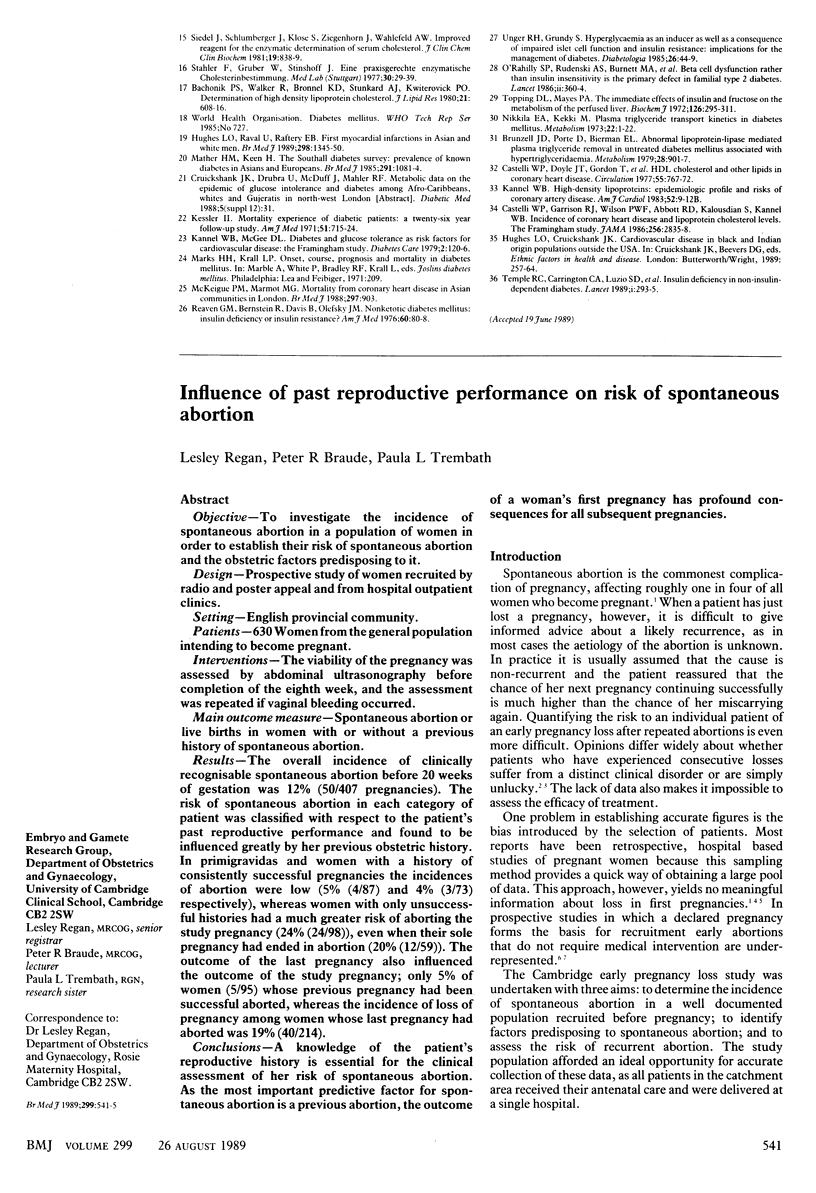
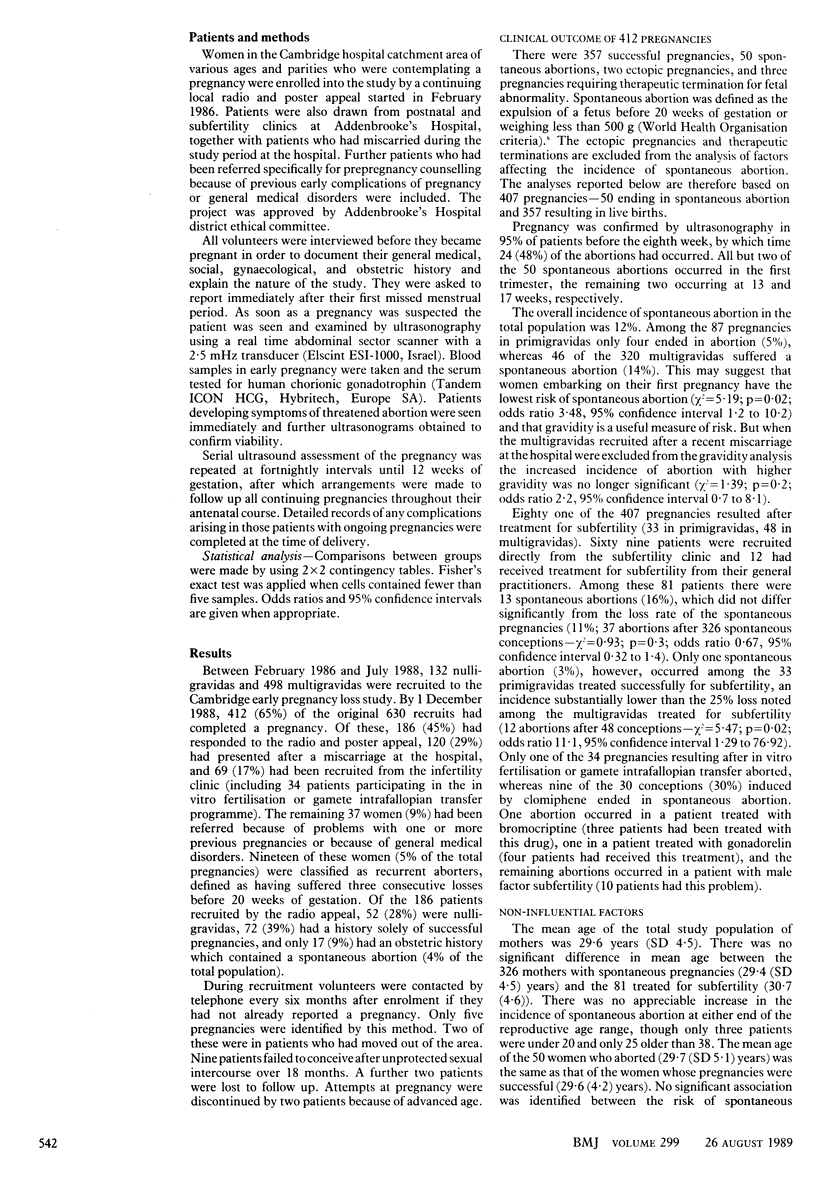
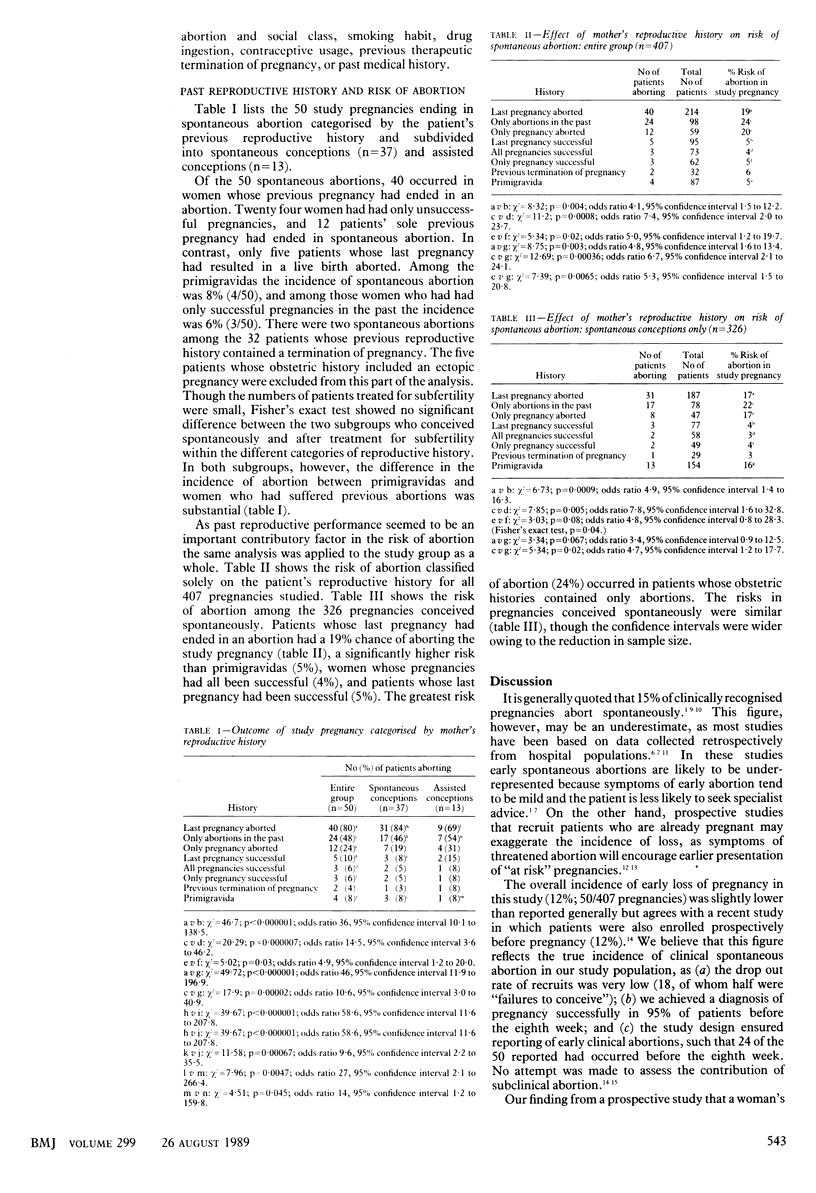
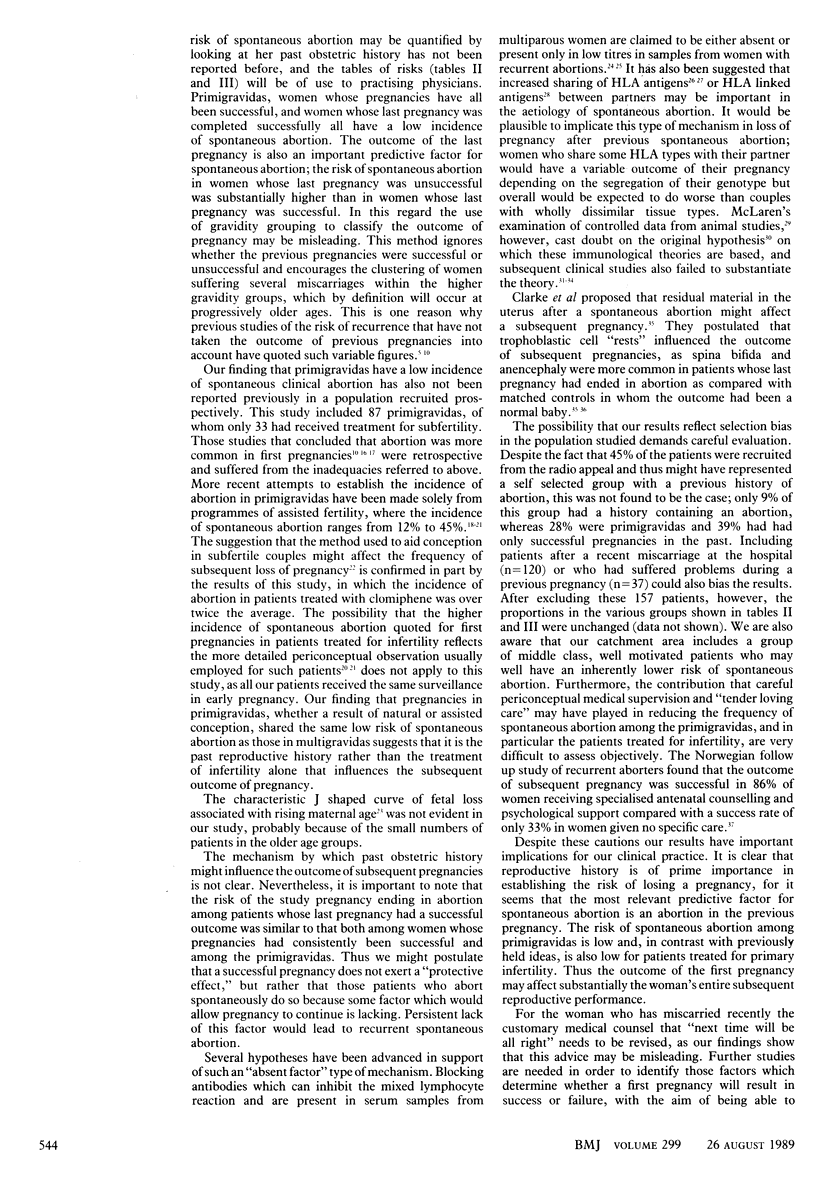
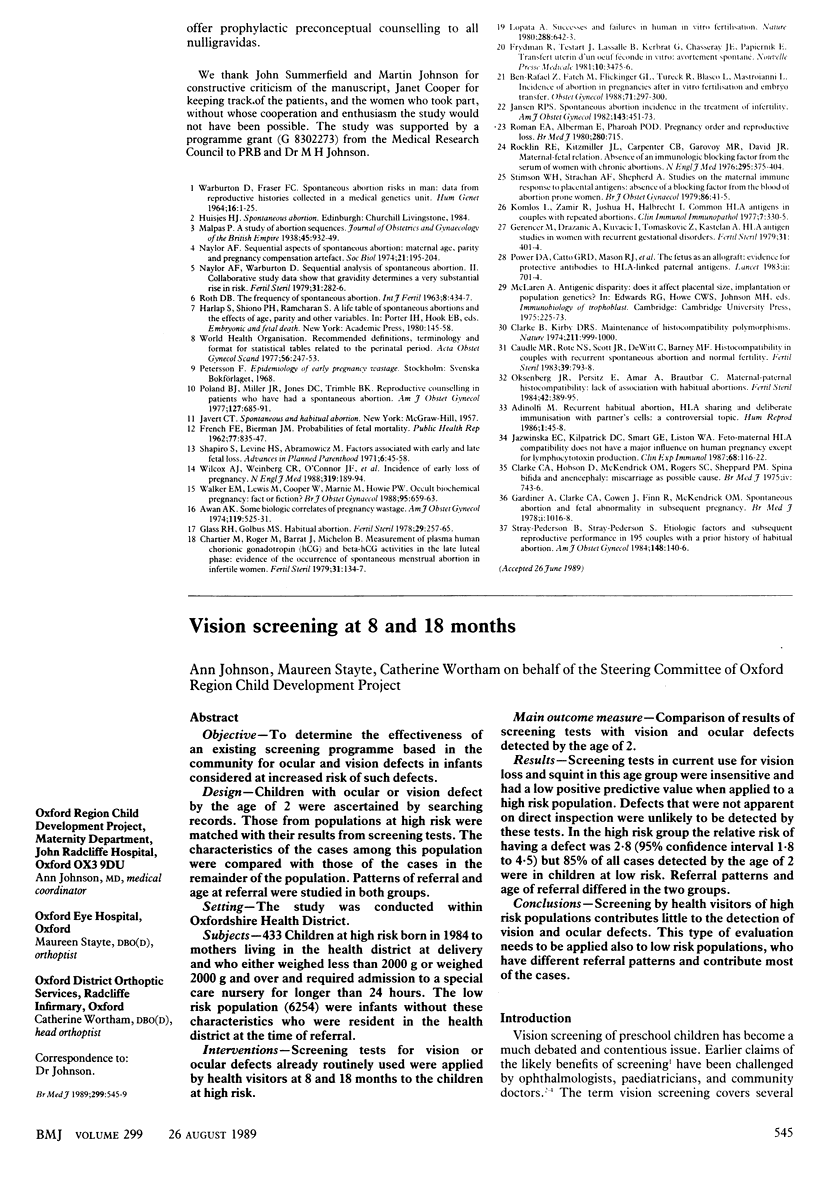
Selected References
These references are in PubMed. This may not be the complete list of references from this article.
- Awan A. K. Some biologic correlates of pregnancy wastage. Am J Obstet Gynecol. 1974 Jun 15;119(4):525–532. doi: 10.1016/0002-9378(74)90214-2. [DOI] [PubMed] [Google Scholar]
- Caudle M. R., Rote N. S., Scott J. R., DeWitt C., Barney M. F. Histocompatibility in couples with recurrent spontaneous abortion and normal fertility. Fertil Steril. 1983 Jun;39(6):793–798. doi: 10.1016/s0015-0282(16)47119-0. [DOI] [PubMed] [Google Scholar]
- Chartier M., Roger M., Barrat J., Michelon B. Measurement of plasma human chorionic gonadotropin (hCG) and beta-hCG activities in the late luteal phase: evidence of the occurrence of spontaneous menstrual abortions in infertile women. Fertil Steril. 1979 Feb;31(2):134–137. doi: 10.1016/s0015-0282(16)43812-4. [DOI] [PubMed] [Google Scholar]
- Clarke B., Kirby D. R. Maintenance of histocompatibility polymorphisms. Nature. 1966 Aug 27;211(5052):999–1000. doi: 10.1038/211999a0. [DOI] [PubMed] [Google Scholar]
- Clarke C., Hobson D., McKendrick O. M., Rogers S. C., Sheppard P. M. Spina bifida and anencephaly: miscarriage as possible cause. Br Med J. 1975 Dec 27;4(5999):743–746. doi: 10.1136/bmj.4.5999.743. [DOI] [PMC free article] [PubMed] [Google Scholar]
- FRENCH F. E., BIERMAN J. M. Probabilities of fetal mortality. Public Health Rep. 1962 Oct;77:835–847. [PMC free article] [PubMed] [Google Scholar]
- Gerencer M., Drazancić A., Kuvacić I., Tomasković Z., Kastelan A. HLA antigen studies in women with recurrent gestational disorders. Fertil Steril. 1979 Apr;31(4):401–404. [PubMed] [Google Scholar]
- Glass R. H., Golbus M. S. Habitual abortion. Fertil Steril. 1978 Mar;29(3):257–265. doi: 10.1016/s0015-0282(16)43149-3. [DOI] [PubMed] [Google Scholar]
- Jazwinska E. C., Kilpatrick D. C., Smart G. E., Liston W. A. Feto-maternal HLA compatibility does not have a major influence on human pregnancy except for lymphocytotoxin production. Clin Exp Immunol. 1987 Jul;69(1):116–122. [PMC free article] [PubMed] [Google Scholar]
- Komlos L., Zamir R., Joshua H., Halbrecht I. Common HLA antigens in couples with repeated abortions. Clin Immunol Immunopathol. 1977 May;7(3):330–335. doi: 10.1016/0090-1229(77)90066-6. [DOI] [PubMed] [Google Scholar]
- Lopata A. Successes and failures in human in vitro fertilization. Nature. 1980 Dec 25;288(5792):642–643. doi: 10.1038/288642a0. [DOI] [PubMed] [Google Scholar]
- Naylor A. F. Sequential aspects of spontaneous abortion: maternal age, parity, and pregnancy compensation artifact. Soc Biol. 1974 Summer;21(2):195–204. doi: 10.1080/19485565.1974.9988106. [DOI] [PubMed] [Google Scholar]
- Naylor A. F., Warburton D. Sequential analysis of spontaneous abortion. II. Collaborative study data show that gravidity determines a very substantial rise in risk. Fertil Steril. 1979 Mar;31(3):282–286. [PubMed] [Google Scholar]
- Oksenberg J. R., Persitz E., Amar A., Brautbar C. Maternal-paternal histocompatibility: lack of association with habitual abortions. Fertil Steril. 1984 Sep;42(3):389–395. doi: 10.1016/s0015-0282(16)48078-7. [DOI] [PubMed] [Google Scholar]
- Power D. A., Catto G. R., Mason R. J., MacLeod A. M., Stewart G. M., Stewart K. N., Shewan W. G. The fetus as an allograft: evidence for protective antibodies to HLA-linked paternal antigens. Lancet. 1983 Sep 24;2(8352):701–704. doi: 10.1016/s0140-6736(83)92246-8. [DOI] [PubMed] [Google Scholar]
- ROTH D. B. The frequency of spontaneous abortion. Int J Fertil. 1963 Jan-Mar;8:431–434. [PubMed] [Google Scholar]
- Roman E. A., Alberman E., Pharoah P. O. Pregnancy order and reproductive loss. Br Med J. 1980 Mar 8;280(6215):715–715. doi: 10.1136/bmj.280.6215.715-b. [DOI] [PMC free article] [PubMed] [Google Scholar]
- Stray-Pedersen B., Stray-Pedersen S. Etiologic factors and subsequent reproductive performance in 195 couples with a prior history of habitual abortion. Am J Obstet Gynecol. 1984 Jan 15;148(2):140–146. doi: 10.1016/s0002-9378(84)80164-7. [DOI] [PubMed] [Google Scholar]
- WARBURTON D., FRASER F. C. SPONTANEOUS ABORTION RISKS IN MAN: DATA FROM REPRODUCTIVE HISTORIES COLLECTED IN A MEDICAL GENETICS UNIT. Am J Hum Genet. 1964 Mar;16:1–25. [PMC free article] [PubMed] [Google Scholar]
- Walker E. M., Lewis M., Cooper W., Marnie M., Howie P. W. Occult biochemical pregnancy: fact or fiction? Br J Obstet Gynaecol. 1988 Jul;95(7):659–663. doi: 10.1111/j.1471-0528.1988.tb06526.x. [DOI] [PubMed] [Google Scholar]
- Wilcox A. J., Weinberg C. R., O'Connor J. F., Baird D. D., Schlatterer J. P., Canfield R. E., Armstrong E. G., Nisula B. C. Incidence of early loss of pregnancy. N Engl J Med. 1988 Jul 28;319(4):189–194. doi: 10.1056/NEJM198807283190401. [DOI] [PubMed] [Google Scholar]


